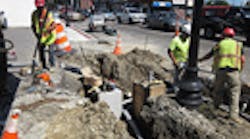The U.S. House of Representatives has unanimously passed legislation to extend federal highway, transit and highway safety programs.
The bill authorizes federal highway, transit and safety programs through March 31, 2012, at current funding levels. The current extension in place expires at the end of this month.
As for action on the other side of Capitol Hill thus far, last Thursday, the Senate Environment and Public Works Committee voted unanimously to extend surface transportation programs also - albeit only through Jan. 31, 2012.
The House measure (H.R. 2887) was introduced with strong bipartisan support by Transportation Committee Chairman John L. Mica (R-FL), Transportation Committee Ranking Member Nick J. Rahall (D-WV), Aviation Subcommittee Chairman Tom Petri (R-WI), Highways and Transit Subcommittee Chairman John J. Duncan, Jr. (R-TN), Ways and Means Committee Chairman Dave Camp (R-MI), Ways and Means Ranking Member Sander Levin (D-MI), and Rep. John Lewis (D-GA).
The House also passed an extension of the long-term FAA bill.
“While this legislation signifies a bipartisan, bicameral agreement to move forward, it must not be just a temporary Band-aid for our important aviation, highway, rail and safety programs and for job creation,” Mica said in a written release. “To build our nation’s infrastructure and put people to work, we need long-term authorizations of these programs.
“Unfortunately,” he continued, “this bill is the 22nd FAA extension and the 8th surface transportation extension. Congress has delayed passing a long-term FAA bill for over four years, and a surface transportation bill for two years. This action represents a last chance to roll up our sleeves and get transportation projects in America moving again.”
“I am hopeful this will be our last short-term extension and a comprehensive highway bill can be passed soon,” said Duncan. “By passing a long-term reauthorization bill, Americans will be able to see their tax dollars going towards rebuilding and strengthening our Nation’s highways, bridges, and transit systems.
“This extension will allow state DOTs to continue to deliver jobs for our nation's economy while maintaining the funding continuity needed to operate and maintain a national transportation system,” said John Horsley, executive director of the American Assn. of State Highway and Transportation Officials (AASHTO). “We congratulate Sen. Boxer (D-CA) and Rep. Mica (R-FL), as chairs of their respective Senate and House committees, for their leadership and support for a national job creating and sustaining surface transportation program.”
According to AASHTO, the National Surface Transportation Policy and Revenue Study Commission’s 2008 Report stated that an investment of at least $225 billion per year in highways, transit and rail is required for the next four decades. AASHTO pointed out that “the bipartisan panel determined that today the country is investing at less than 40% of what is needed. Over the past 20 years, the federal share of highway and transit capital investment has averaged 45%.”
AASHTO has put together its own list of “smart solutions” for what federal funds for highway-infrastructure projects should accomplish in the near future:
- Aggressive traffic-management practices utilizing intelligent transportation systems to minimize traffic delay, improve flow, and safety
- Advanced construction and maintenance techniques to get the job done faster, cheaper, and safer
- Longer-lasting materials to extend periods between major pavement and bridge maintenance and replacement work
- Design practices that maintain high standards of quality while enabling flexible solutions responsive to environmental and community priorities
- “Premium services,” such as “through special lanes” for Bus Rapid Transit vehicles, High Occupancy Toll (HOT) lanes, which provide faster lanes for those willing to pay, and managed lanes which separate truck traffic from passenger vehicles.




